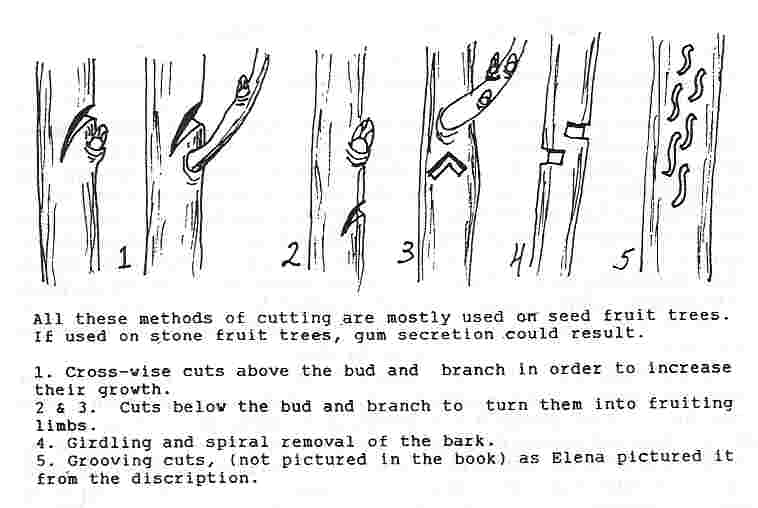nafex@lists.ibiblio.org
Subject: North American Fruit Explorers mailing list at ibiblio
List archive
- From: Jwlehman@aol.com
- To: nafex@lists.ibiblio.org
- Subject: Re: [NAFEX] Notching to influence tree growth.
- Date: Mon, 20 Dec 2004 10:35:01 EST
Hello Joe,
Don't know if this will help, but here is a report I wrote and published in the Fall 1993 issue of Pomona. I don't recall that we particularly looked at the results of using cuts. However they did a large amount of beautiful espalier and imagine to help obtain results they were looking for used grooving cuts often.
You may need to widen your window to see all of the picture below.
USING CUTS TO INFLUENCE FRUIT TREES
Jerry Lehman, 7780 Persimmon St. Terre Haute, IN 47802-4994
One of the places visited while on the 1991 NAFEX trip to Russia was the botanical gardens at Kiev. There we saw a lot of work being done with form gardening or espalier. Dr. Ivan M. Shaitan took us through the gardens and explained what we were seeing. He gave us copies of a book he had written titled, Beautiful Gardens that Bear. Professor Elena Merenov who teaches the Russian language at a local college contributed by doing the direct translation. Elena is an educator not a horticulturist, which made translating this subject matter challenging for us. If there is sufficient interest within NAFEX members we would be willing to translate more of Dr. Shaitan's book.
Dr. Shaitan: In form gardening we often need to fill empty space in the tree being formed. The following methods can be used.
CROSSWISE CUTS are made above the buds in order to increase their vegetative growth. Cut a strip of bark (3-4 mm) with the wood. If the cut is done under the bud it will prevent it from forming a vegetative shoot. A cut under a strong branch will weaken its growth. We recommend to make the cuts at the end of March or at the beginning of April. [Kiev is at about the same latitude as Regina, Saskatchewan, with a slightly more moderate climate according to my atlas--GW, Pomona Editor]
GROOVlNG CUTS can be used to increase the growth in thickness of trunk and skeleton branches. Make longitudinal cuts with the help of an orchard knife, also remove some sapwood with the bark. On the place of the cut, new tissues will appear and this part will become thicker. This type of cutting is made in a faltering line.
Grooving cuts could be used also to treat wounds, tumor growths or mechanical damage of the bark. In such cases the cuts are made approximately 10 cm (4 inches) above the wounds and end below the wound.
Grooving cuts should be done in the beginning of the vegetative period from the northen (shadow) side of the tree. Do not use this method on the old trees with broken bark, which grow slowly.
CIRCULAR CUTS of the bark are recommended for strong growing branches in order to turn them into fruiting limbs. The accumulation of plastic substances [sugars?] (assimilants) results in the forming of flower buds. In case of the presence of pollinated flowers the fruits become bigger and are ripened earlier. Circular cuts are also used in the formation of palmates on strong central bearers which have overgrown the height of the formation of the next layer.
With the help of the orchard knife or special secateurs which can take a part of the wood along with the bark, remove the bark (4-8 mm wide [0.25 inch, more or less]) in the form of a circle or spiral cut. This operation is usually done in May or in 20 to 30 days after total blossoming of the trees to favor the making of flower buds. The wounds from circular cuts heal up (close) in one to two years. To improve this process you can cover them with grafting wax.

END
Since writing this Elena has become a US citizen along with her husband Andy and living in Texas. Each have a Ph. D. She is working in human resources and he at Dow Chemical. Their only son Roman is in the US Air Force serving in MN and loves it. He, just as his parents, is well educated. Some of you will remember Elena as she acted as translator upon two visits of Russian attendees of the NAFEX annual meetings (State College, PA and Decature, AL)
If any of you that have met her wish to send her a congratulatory e/m contact me off line.
Jerry Lehman
-
Re: [NAFEX] Notching to influence tree growth.,
Jwlehman, 12/20/2004
- Re: [NAFEX] Notching to influence tree growth., Doreen Howard, 12/20/2004
Archive powered by MHonArc 2.6.24.